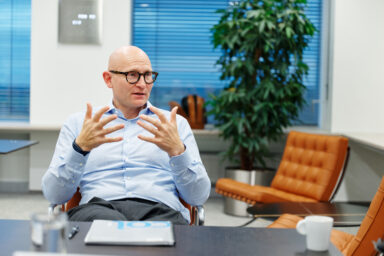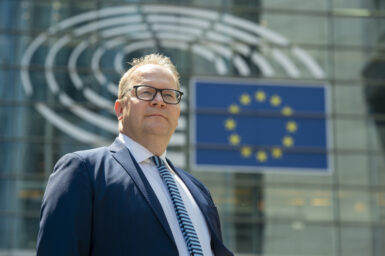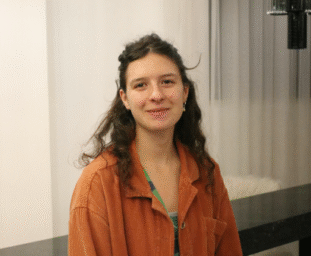Europe’s energy future rarely sounds simple. Yet all the targets, pledges and acronyms may boil down to one idea: join the wires. “Connection is not just our best solution, it is our only solution,” Dan Jørgensen, the EU’s energy commissioner insisted during Thursday’s hearing of the Parliament’s industry committee.
Europe’s next mega-project will not soar like a bridge or rumble like a railway. It will hum, quietly, through a thicker tangle of cables that Commissioner Jørgensen wants strung across the continent. An electric skeleton is to knit 27 power markets into one and jolt Europe’s energy transition back to life, regardless of the sources. That sums up the message he presented to the parliamentary committee on industry, research and energy (ITRE) during a public hearing on energy issues on 20 November.
Fewer butterflies
Twelve months earlier Mr Jørgensen had taken office amid war, sky-high gas prices and fears of blackouts. A year on, he offered mild comfort. “I had more butterflies in my belly a year ago than I have today,“ he said. The Dane spoke amicably, without notes, reminding members that not long ago he sat among them. But the levity soon dissolved into a sober message. Europe’s grids, he said, risk becoming “the biggest challenge we face and the biggest danger for electrification”.
The State of the Energy Union report, published in early November, showed progress on slashing Russian fossil imports and rolling out renewables. Even so, the front line has shifted. Record additions of solar and wind—89 GW this year—now bump against cables too thin and permits too slow. “Our aim is simple. No more barriers, no more bottlenecks,” he said. “Instead, a 21st-century European grid connecting all corners of our continent.”
Mr Jørgensen went on with a promise to table a “European grid package” within weeks. It will revise the rules that guide cross-border projects, streamline permits and offer a toolbox for easing congestion. Crucially, it will inject Brussels into planning. “We need more centralised planning…We don’t have the time, and it hasn’t happened,” he argued. Member states may flinch at the intrusion, but the commissioner insisted that, without it, electrification will stall and decarbonisation will fail.
You might be interested
Plugging the gaps
Southeastern Europe illustrated the stakes. One Bulgarian member noted that households there pay up to five times more for power than northerners because interconnectors remain scarce. Mr Jørgensen nodded. “Prices are way too high. Industry…is struggling. We have energy poverty in our union.” Last year 47 m people could not heat their homes, he reminded the room. The grid plan, he vowed, “will address these challenges in Southeastern Europe”, backed by fresh cash in the EU’s budget review.
Money is only part of the fix. Delays dog investment. Mr Jørgensen cited Germany, which loses €4 bn of electricity each year through curtailment because lines cannot carry the surplus. Across the EU gigawatts of projects wait in queues. Hence the commissioner’s pledge to publish guidance on grid connections, harmonise waiting-list rules and impose “specific deadlines for project approval”, as one Danish MEP had urged. “Electrification is at the centre of our transition…If we don’t make that happen much faster, we will lose out,” he warned.
We need more centralised planning. — Dan Jørgensen, EU energy commissioner
The grid package is only the first plank. Next year brings an electrification plan, a clean-energy investment strategy and a heating-and-cooling roadmap. All share one theme: pooling effort and risk at EU level. “With our allocation of five times more money for safe energy in our MFF proposal, we also show that we’re willing to put money behind this,” Mr Jørgensen said. Private capital, de-risked by guarantees and clearer rules, must do the rest.
Wiring the electro-state
The commissioner likes historical sweep. The industrial age, he said, was dominated by “petrol states”. Now China looms as the first electro-state, built on vast, cheap electricity. Europe, he implied, must emulate the model or accept decline. But its advance has faltered. “Electrification in Europe has more or less stagnated within the last decade. This needs to change,” he declared. The answer is to add renewable capacity even faster than today’s breakneck pace—and to move the electrons freely.
That prospect unnerves some capitals. Planning at EU level sounds like power slipping from national ministries to Brussels and the European Network of Transmission System Operators. Mr Jørgensen assured members that member states would keep the final say, yet he stressed urgency. Regional squabbles have left “missing links” across borders. “It has to be a wake-up call,” he said. “If we want a well-functioning energy union where nobody’s left behind…some countries are left behind. That will not work.”
The grid push also colours other files. Negotiators were due to conclude talks that evening on the RepowerEU regulation, channelling recovery funds into energy projects. Mr Jørgensen thanked the committee for its graft and urged swift agreement. The broader clean-investment strategy, due next year, will seek to “unlock the private investments that we need…through a shared and strategic European approach.” In Brussels argot that means more conditionality, more scrutiny and likely more rows.
Currents vs. cross-currents
Politics complicates the wiring job. A Patriots of Europe member asked whether the Commission would bless Germany’s plan to cap industrial electricity at five cents per kilowatt-hour. Mr Jørgensen replied that national schemes were “possible within EU law”, though they must respect state-aid limits. Another worried that a vast LNG deal with America would tie Europe to foreign suppliers and undermine home-grown nuclear technology. The commissioner deflected: the EU does not buy gas itself, he noted, but it can “facilitate” imports while pursuing an SMR—small modular reactor—strategy of its own.
Indeed nuclear featured often. MEP Sophie Wilmès (Renew/BEL) warned that American reactors could crowd out European designs. Mr Jørgensen promised an “SMR strategy early next year” and highlighted a recent Commission report suggesting nuclear capacity could rise, not fall, by mid-century if new technologies mature. Yet renewables will grow faster, he added. “Whether you’re pro-nuclear or against…there’s no argument for not being better connected in Europe.”
Electrification is at the centre of our transition. If we don’t make that happen much faster, we will lose out. — Dan Jørgensen
Buildings drew similar scrutiny. Isabella Lövin (Greens-EFA/SWE) lamented sluggish renovation rates and sliding shares of renewable heat. Energy efficiency, replied Mr Jørgensen, “is not going fast enough”. Investments in insulation pay back within five years, yet still lag; 40% of emissions come from buildings. He promised a heating-and-cooling strategy, praising district-heating schemes in Copenhagen and Berlin as proof that green comfort need not cost a fortune—or depend on Russian gas.
Power to the people
Citizens will feature in next year’s “energy package”. Some activists fear extra bureaucracy; Mr Jørgensen countered that the goal is the opposite. Local energy communities, collective buying and easier switching between suppliers can shave bills. He recalled Swedish consumers who saved 40% simply by choosing a better tariff online. The commissioner wants such gains spread across the bloc, though the reforms will test political stamina: municipalities relish control over permits, and incumbents dislike fresh rivals.
Enforcement looms too. In the past year the Commission opened 73 infringement cases in energy and closed 55. Pre-infringement dialogues, the commissioner said, resolve breaches before litigation. He held “two constructive implementing dialogues” on permitting and product laws. Yet more will follow. Mr Jørgensen’s mantra—grids, permits, planning—demands that capitals turn words into substations. When they drag their feet, Brussels must prod.
The parliamentarians, many battle-hardened from drafting last term’s Green Deal laws, seemed broadly supportive. Mr Jørgensen ended on a conciliatory note. “My door is always open,” he told the room. Still, his closing appeal masked impatience. Europe’s energy system, he said, needs a “paradigm shift” towards top-down coordination. The coming grid package will test whether national pride bends to continental necessity.
A continental lattice
If the plan works, the EU could slash curtailment losses, speed electrification and cut the €400 bn it still spends each year on imported fossil fuels. Cheaper power would firm up industrial competitiveness and blunt populist angst over bills. Failure would entrench a patchwork where German consumers dump surplus renewables while Balkan neighbours burn lignite and pay triple for electricity.
Commissioners seldom reveal the core of their ambitions in a single hearing. Mr Jørgensen, chatting easily with ex-colleagues, did exactly that. “The future is electrical,” he said. The cables to carry that future, however, remain half-built. Turning wires into Europe’s new arteries will demand cash, compromise and a thick skin in Brussels. But, as the commissioner reminded MEPs, the old model of fragmented grids and fossil imports is no longer tenable. Connection, he repeated, is the only solution.





